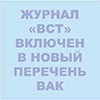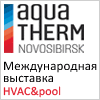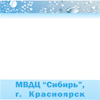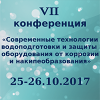Number 9 / 2017
To download all number in format PDF (in Russian)The further text is accessible on a paid subscription.
For authorisation enter the login/password.
Or subscribe
Number maintenance (pdf) (doc)
Number abstract (doc)
Literature lists to articles (doc)
|
bbk 000000
UDC 628.21:504.06
Drachikov S. A., Ivanov Mikh. Val., Vorob'ev V. S., Mit'kova E. E.
Evaluation of the harmonization of the environmental requirements
Summary
Evaluation of the active environmental documents – federal laws, RF Governmental Decrees, methods, environmental requirements – in relation to their harmonization was carried out. Inconsistencies in the names and designations of the same pollutants in different regulatory documents were revealed. It was found that the requirements to the maximum permissible concentrations of pollutants in commercial fishing water bodies and chemicals in water bodies used for public water supply and recreation lack detergents regulated by the environmental protection authorities. Proposals on eliminating the revealed inconsistencies were made. In this regard it is expedient to develop and adopt a document specifying the way of making VAT calculations, determining the succeeding charge for discharging pollutants into water bodies based on the main characteristics typical for domestic wastewater and surface runoff, and to compile a complete, single for all the natural resource users list of the regulated pollutants. Besides, it is necessary to issue Appendix to RF Governmental Decree No. 913 comprising the uniform methods of analyses of all the regulated pollutants or give references to the existing methods.
Key words
environment , negative impact , нормативы допустимых сбросов , water bodies of commercial fishing importance , water bodies used for public water supply and recreation
|
bbk 000000
UDC 581.526.325
Babaev A. V., Zamana G. T., Puklakov V. V.
Model prediction of water quality patterns
in the Mozhaiskoe water reservoir under the heat wave conditions
Summary
The issues of water quality in water reservoirs used for public water supply are of primary concern. Intensive phytoplankton development in them is a most common problem in water supply. Therefore the selection of tools that provide for predicting to a high degree of accuracy the processes of water quality formation in water reservoirs under various hydro meteorological summer conditions is a task of primary importance. The results of the model prediction of the basic water quality patterns under the heat wave conditions and of the diagnostic calculation of the environmental conditions of the Mozhaiskoe water reservoir in 2014 carried out according to GMV-MGU model and verified by the field studies data are presented. The verification showed good reproduction of the water quality patterns of the Mozhaiskoe water reservoir by the model. The comparison of the model prediction results, diagnostic calculation and field studies data showed that the model prediction of the water reservoir conditions for the minimum winter storage decrease, low flow spring tide and excessive summer heat is coherent with the actual 2014 pattern when similar hydro meteorological conditions were observed. GMV-MGU model can be used for predictions and diagnostic calculations of water quality patterns in the water reservoirs used for public water supply in the process of planning the measures on operating and long-term control of hydroengineering facilities and water intakes operation.
Key words
simulation , water quality , reservoir , phytoplankton , heat wave , anoxia
Read more ...
|
bbk 000000
UDC 628.166
Ponomarev A. P., Podolets A. A., Макина О. А.
The use of aqueous extract of shungite mineral for the removal
of bacterial flora from water
Summary
Safe and high quality drinking water is the most important factor that is effecting the human health, rise in births, reduction of mortality, increased expectation of life. The objective of the present work was model developing of the method of removing bacterial flora from water with the use of shungite, unique natural mineral. The key point of using this mineral for water purification is in using crushed shungite not as a feed but for the production of aqueous extract of minerals. In the process of adding refined and concentrated shungite extract into drinking or other water the effect of active complexing of its organic component was defined. The process of extracting minerals from crushed shungite will be most efficient in acidic aqueous media with pH 2–2.5; herewith macro- and microelements and rare-earth ultramicroelements – lanthanoids pass into water. To concentrate the extracted minerals water was evaporated by regular boiling to 1/10 of the original volume with pH 2–2.5. Removal macro- and microelements from extract with preserving lanthanoids was carried out in the process of de-acidification with sodium hydroxide solution with subsequent extract clarification by centrifuging. Addition of 1% shungite extract into raw water is accompanied by the formation of organic suspension that is removed during filtration, sedimentation or centrifuging. At that the mineral composition of water does not essentially change. The mechanism of removing bacterial flora from water is conditioned by the physical and chemical interaction of high-reactive cations of lanthanoids (+3 valence) with bacterial cells initiating their complexing. The phenomenon of selective coagulation of bacterial cells is caused by the reaction of lanthanoid cations complexing with nucleic acids of microorganisms. It is expected that the reaction of nucleic acid with metal is performed by phosphate groups.
Key words
membrane filter , bacteria , минерал шунгит , aqueous extract , lanthanoids , de-acidification
Read more ...
|
bbk 000000
UDC 628.3
Smirnov Aleksandr Vladimirovich
Advanced engineering and experience of BAT implementation
Summary
The use of the Information-Technical Guidebook on the best available techniques «Wastewater treatment in public wastewater disposal systems of communities, urban districts» (ITS 10-2015) provides for only a general idea of the catalogue of technologies that have to be applied in order to ensure high efficiency of wastewater treatment. The choice and substantiation of a particular technology are carried out on the basis of the operation experience and comprehensive project engineering. Case studies of using «MY Technologies» that are ready-made technical solutions of mechanical («MY MET») and biological («MY BIO») wastewater treatment for the wastewater treatment facilities in Sochi, Vologda, Kolomna are presented.
Key words
wastewater , biological treatment , mechanical treatment , best available techniques , primary treatment , fine purification , «MY Technologies» , «MY MET» , «MY BIO»
Read more ...
|
bbk 000000
UDC 628.33:622.692.5
Sakulin A. S.
Comprehensive process solutions for oily wastewater treatment
Summary
The demand for a comprehensive solution of the problems of construction and upgrade of the local wastewater treatment facilities necessitates the need in manufacturing equipment sets that provide for the complete oily wastewater treatment cycle. Based on the experience in this field a most efficient economically feasible technology of industrial wastewater treatment – dissolved-air chemical flotation with subsequent filtration in different filter types is proposed. «Ecoservice» Company has developed modular treatment facilities placed in container units or demountable buildings. These are ECO-LS units (for storm water treatment), ECO-AM (for car wash sites) etc. For the enterprises of «Russian Railways» ECO-NS unit was developed that had a compliance certificate and an expert report of Rospotrebnadzor. In this unit the comprehensive approach to the treatment technology – chemical dissolved air flotation, mechanical filtration and sorption was implemented. The versatility of this scheme is in the use of different flotation units depending on the wastewater pollution level. Besides, the use of different filter media provides for eliminating specific pollutants – ammonium, phenols, heavy metals. The complex unit is designed for wastewater treatment to the standard of effluent discharge into fishery water bodies. Despite the fact that the given complex unit has been developed for «Russian Railways» enterprises it can be used in other industries to remove oil products from wastewater.
Key words
filtration , sorption , local treatment facilities , oil effluents , comprehensive technology , chemical flotation , modular treatment facilities
Read more ...
|
bbk 000000
UDC 628.35:66.081.63
Kalachev D. A.
New age of membrane technologies: HUBER VRM unit
Summary
The information on the developments of HUBER Company in the field of wastewater and sludge treatment with the use of advanced technologies is presented. The company experts have been developing various system options: from mechanical treatment to hi-tech membrane biological reactors. The use of membrane bioreactor provides for reducing the volume of aeration tanks, since it ensures operating biological treatment stage with activated sludge concentration up to 8 g/l (or to 12 g/l in the MBR filtration chamber); abandoning secondary settling tanks, tertiary treatment and disinfection stages (if needed) resulting in the reclamation of additional space. Beside strict requirements to the efficiency of treatment it is important to note the reduction of operation expenditures, for energy in particular. HUBER Company has developed a reliable and energy efficient solution – HUBER VRM membrane unit. The basic innovative solution in the designed membrane filtration unit is a unique AirBoost system.
Key words
energy efficiency , membrane bioreactor , membrane filtration , wastewater and sludge treatment , membrane flushing
Read more ...
|
bbk 000000
UDC 628.212.2/.316
Vatin N. I., PANKOVA G. A., Leonov L. V., Probirsky M. D., Rublevskaya O. N., Chechevichkin A. V., Iakunin L. A.
Test operation of FOPS® filter with natural zeolite
for infiltrate polluted surface runoff treatment
Summary
Infiltration effluent often causes heavy pollution of surface runoff with heavy metal ions. The purpose of the present work was testing the operation in-situ of a cartridge filter with natural zeolite for surface runoff treatment polluted with heavy metals from infiltrate. The results of studying the level of pollution of storm runoff from industrial site are presented. As part of the study the following challenges were addressed: study of formation of surface runoff heavily polluted with infiltrate at the site and treatment options; implementation of sorption-filtration technology in a real project with the use of filters for surface runoff treatment (FOPS®) installed in sewer manholes; evaluation of the possible removal of heavy metal ions from real runoff with natural zeolite-clinoptololite. Possible purification of the studied runoff with the use of FOPS®-TS filter with natural zeolite was substantiated. It was shown that ultra high concentrations of aluminium, zinc and copper are formed in infiltrate entering the drainage system on site. Using FOPS®-TS filter provided for the high efficiency of aluminium, zinc, copper and iron removal during the test period (April – October).
Key words
surface runoff , sewer manhole , filter cartridge , infiltrate
Read more ...
|
bbk 000000
УДК
Потенциал моря для отопления и охлаждения зданий
Аннотация
Разработка новых, экологически приемлемых технологий для отопления и охлаждения жилых и коммерческих помещений является одной из ключевых задач для многих энергетических компаний по всему миру. Использование энергии солнца, морских приливов и течений, ветра и тепла, а также получаемой из недр земли в той или иной степени доказало свою практическую пользу, эффективность и рентабельность.
Read more ...
|
bbk 000000
UDC 628.144:532.542
Prodous O. A., Vasil'eva M. A.
Simplified form of the normative dependence for hydraulic calculation of pipelines made of polymer materials (to be discussed)
Summary
Hydraulic calculation of pipelines (pipes) made of polymeric materials is regulated by the acting regulatory documents (SP 40-102-2000). In the aggregate a method (sequence) of hydraulic calculation of pipelines made of polymeric materials with the use of a simplified form of the normative dependence for determining hydraulic resistance coefficient is proposed. The calculation method is of practical interest because it is confined to the determination of three values included into the normative calculation dependence for the subsequent determination of head losses along the pipeline length. The hydraulic calculation method includes new parameters: hydraulic potential of a pipeline, effective fluid flow rate, effective roughness of the inside pipe surface, effective pipe diameter. These parameters and the Calculation Method have been included into the 3rd edition of the complemented material of Reference book «Tables for hydraulic calculation of pressure polyethylene pipes» (2017). The simplified form of the normative dependence and the method of making hydraulic calculations of pipelines made of polymeric materials can be considered to be included into the revised version of SP 40102-2000.
Key words
hydraulic design , hydraulic resistance , calculation method , polymer pipes , hydraulic roughness
Read more ...
|
|












